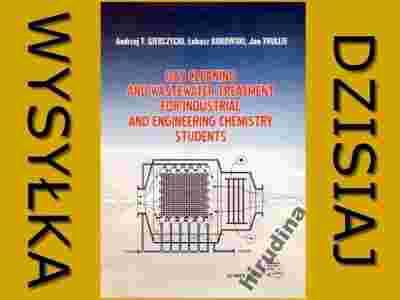|
WYSYŁKA DZISIAJ !!!
CODZIENNIE W DNI ROBOCZE
WYSTARCZY DO GODZ. 13.00 wysłać do nas:
1) deklarację odbioru przesyłki "za pobraniem"
lub
2) skan przelewu
albo
3) wpłacić za pośrednictwem "Płacę z Allegro"
GAS CLEANING AND WASTEWATER TREATMENT FOR INDUSTRIAL AND ENGINEERING CHEMISTRY STUDENTS
Andrzej Gierczycki, Łukasz Kurowski, Jan Thullie
Stan książki: NOWA
Wydawnictwo Politechniki Śląskiej 2011
Stron: 146
Nakład: 250 egz.
Okładka: miękka
Format: B5
POLECAMY RÓWNIEŻ INNE KSIĄŻKI W DZIALE:
OCHRONA ŚRODOWISKA
Opis:
Praca prezentuje metody i urządzenia stosowane przy oczyszczaniu spalin i innych mediów lotnych a także przy oczyszczaniu wód poprzemysłowych. Książka przeznaczona jest dla studentów specjalności inżynieria chemiczna.
Z okładki:
This book is addressed to students specialised in Industrial and Engineering Chemistry and may also be helpful for those who study environmental protection and related subjects. The course is divided into two parts, viz. gas cleaning and wastewater treatment hirudina and presents basie methods and process equipment. The book is richly illustrated with simple drawings and plots, therefore rendering the reading easy and pleasant.
Key words:
• gas cleaning
• water cleaning
• absorption
• adsorption
• sedimentation
• swingtherm
SPIS TREŚCI:
PREFACE........................................................................................... 7
PART 1. GAS CLEANING
1. INTRODUCTION............................................................................... 9
1.1. Gas cleaning techniques and devices.................................................... 9
1.2. Characteristics of contaminant source.................................................. 10
1.3. Dust and gaseous contaminants removal efficiency.................................... 11
2. SETTLING CHAMBERS....................................................................... 14
2.1. Movement of a single particie in gravitational forces field.......................... 14
2.2. Howard settling chamber................................................................. 18
3. INERTIAL DUST COLLECTORS............................................................ 20
3.1. Conical concentrator...................................................................... 20
3.2. Movement of a single particie in centrifugal forces field............................ 21
3.3. Backward-running Kowent cyclone................................................... 24
4. WET METHODS............................................................................... 26
4.1. Counter-current spray scrubber and hydraulic nozzles............................... 26
4.2. Venturi scrubber and its atomizers.......................................................... 29
4.3. Froth-cyclonic dust collector............................................................ 31
4.4. Kavag fluidized-bed dust collector..................................................... 32
5. FABRIC FILTERS.............................................................................. 34
5.1. Cloth filter with reverse gas flow....................................................... 35
6. ELECTROSTATIC PRECIPITATORS...................................................... 38
6.1. Capture mechanism........................................................................ 38
6.2. Vertical plate-type electrostatic precipitator............................................... 40
6.3. Efficiency of a precipitator.............................................................. 41
6.4. Process line with the electrostatic dust collector..................................... 43
7. ABSORPTION METHODS.................................................................... 44
7.1. Columns and packings.................................................................... 44
7.2. Counter-current packed column for gas desulphurization........................... 47
7.3. Ionising wet scrubber..................................................................... 49
8. ADSORPTION METHODS................................................................... 50
8.1. Adsorber with a fixed bed and inner regeneration system........................... 51
8.2. Petrolfilter................................................................................. 52
9. COMBUSTION................................................................................. 54
9.1. Thermal and catalytic combustion...................................................... 55
9.2. Vapour supported flarę................................................................... 57
10. MEMBRANĘ PROCESSES FOR GASES.................................................. 59
10.1. Application of GP method for the hirudina removal of VOCs................................. 60
11. BIOFILTRATION AND BIOSCRUBBER METHODS.................................. 62
11.1. Bioscrubbers............................................................................... 62
11.2. Biofilters.................................................................................... 64
PART 2. WASTEWATER TREATMENT
1. WASTEWATER CHARACTERIZATION................................................ 67
2. WATER POLLUTION ........................................................................ 76
2.1. Chemical pollution........................................................................ 76
2.2. Physical pollution......................................................................... 80
2.3. Biological pollution....................................................................... 80
3. CONVENT10NAL WASTEWATER TREATMENT SYSTEMS...................... 82
4. PRIMARY TREATMENT METHODS..................................................... 85
4.1. Grids and screens.......................................................................... 85
4.2. Sedimentation.............................................................................. 87
4.3. Flotation........................................................................................ 93
4.4. Coagulation and flocculation............................................................ 96
5. SECONDARY TREATMENT METHODS................................................102
5.1. Lagoons and stabilization basins........................................................102
5.2. Aeration systems..........................................................................103
5.3. Activated sludge system..................................................................106
5.4. Trickling filters............................................................................108
5.5. Anaerobic wastewater treatment............................................................110
6. TERTIARY TREATMENT METHODS................................................... 112
11 2
6.1. Nitrogen removal......................................................................... 11 2
6.2. Phosphorus removal ...................................................................... l13
6.3. Disinfection................................................................................114
7. SELECTED SLUDGE TREATMENT METHODS.......................................117
7.1. Sludge thickening and dewatering.......................................................... 117
7.2 Sludge drying.............................................................................. 118
7.3. Sludge digestion...........................................................................118
BILIOGRAPHY IN ENGLISH....................................................................121
BIBLIOGRAPHY IN POLISH....................................................................123
INDEX................................................................................................127
ENGLISH-POL1SH GLOSSARY.................................................................131
CHCESZ PRZED ZAKUPEM ZAPOZNAĆ SIĘ Z OFEROWANĄ KSIĄŻKĄ
NAPISZ DO NAS MAILA, A OTRZYMASZ
DARMOWY FRAGMENT!!!
Polecamy nasze pozostałe oferty: 
|
|
|
|
|
|
|
|
|
|
|
|
|  | Panelealle  |
|
|
|

